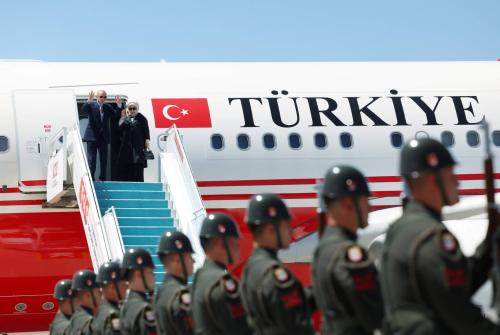Critics of Senator Chuck Hagel’s nomination to be Secretary of Defense cite his views on nuclear arms reduction, including his endorsement of a proposal to cut U.S. nuclear weapons to 900 and his membership in Global Zero, as potentially dangerous to U.S. security. Are Hagel’s positions really over the top?
The senator endorsed a proposal to reduce to 900 total nuclear weapons in a 2012 Global Zero paper. That might be too low for the next step after the New START Treaty. In a recent book—The Opportunity: Next Steps in Reducing Nuclear Arms—Mike O’Hanlon and I proposed a new U.S.-Russia treaty to cut each side to 2000-2500 total nuclear weapons, in large part because we doubt Moscow would agree to go lower without bringing in third-country nuclear arsenals.
The Global Zero paper called for eliminating all intercontinental ballistic missiles (ICBMs) and maintaining 450 nuclear weapons deployed on submarine-launched ballistic missiles and at bomber bases, with another 450 weapons held in reserve. I personally would prefer to keep some ICBMs in the force mix. That said, if our nearest peer competitor, Russia, also reduced to 900 total weapons, what would be wrong with the outcome? The United States could still maintain a secure, reliable, effective and powerful nuclear deterrent; each of the 900 weapons would be many times the explosive force of the bomb that destroyed Hiroshima. Such an agreement, moreover, could offer significant defense budget savings, particularly as we face tough decisions on recapitalizing our strategic nuclear systems.
Twenty years after the end of the Cold War, 900 nuclear weapons ought to suffice to deter Russia. As for third countries, assume that the Global Zero proposal was adopted by the United States and Russia with others agreeing to do nothing more than freeze their arsenals at current levels. That would narrow the gap between the two nuclear superpowers and other countries, but of the next largest nuclear powers, two—France and Britain—are U.S. allies. The third, China, reportedly has about 300 nuclear weapons, but the number that can reach the United States is just 60, less than one-seventh the number of deployed U.S. warheads under the Global Zero plan.
Negotiating a U.S.-Russia treaty to reduce to 900 would not be easy, but if achieved, nuclear deterrence would continue to function. The burden should be on skeptics to explain which third country would act in a dramatically different manner to challenge U.S. security or that of America’s allies.
Critics also express concern about Hagel’s membership in Global Zero (full disclosure: I also am a member). That organization advocates the goal of eliminating all nuclear arms. Almost every American president since 1945 has endorsed zero nuclear weapons as an ultimate goal. In 1986 in Reykjavik, Ronald Reagan came close to an agreement with Mikhail Gorbachev that would have eliminated all U.S. and Soviet nuclear weapons within ten years.
Nuclear deterrence has been a key element of U.S. security policy for decades, and it helped keep the peace between the United States and the Soviet Union during the Cold War—with one big qualifier: at several points, the United States, the Soviet Union and the world got awfully lucky. What would have happened, for example, if John Kennedy had taken the counsel of most of his advisors and ordered air strikes on Cuba, followed by an invasion, instead of a naval blockade? U.S. intelligence did not then know that the Soviet commander on the island had tactical nuclear weapons and had been given authority to use them in the event of an attack.
Will we always be lucky, particularly if the number of nuclear-weapons states increases? At the time of the Cuban missile crisis, four countries had nuclear arms. Today the number is nine. Today the odds of a nuclear weapon being used are greater than during the Cold War. We face the threat of nuclear-armed rogue states and the ultimate nightmare: a nuclear bomb in the hands of a terrorist organization.
A genuinely non-nuclear world would eliminate that risk. It would offer distinct security advantages for the United States, which has friendly neighbors on its borders, the protection afforded by the Pacific and Atlantic Oceans, and the world’s most powerful conventional military. In a world without nuclear weapons, the United States could still practice deterrence to protect itself and its allies. U.S. conventional military capabilities would pose very heavy costs to a potential adversary.
Getting to zero would be hugely difficult, as Hagel and other serious advocates acknowledge. It would require extremely intrusive verification measures, a near automatic enforcement mechanism in the event of cheating, and settlement of long-standing international disputes. Zero nevertheless remains a sensible goal; we can move toward it in a step-by-step process of nuclear arms reductions, even if we do not know if we ultimately can get all the way there or how long it might take.
Reductions to 900 warheads or the ultimate elimination of all nuclear arms will not be simple to achieve. But we should ask two questions. What are the requirements of nuclear deterrence in the 21st century? And can we break out of the nuclear legacy of the past 60 years? Hagel seems to be asking those questions. Choosing to ignore them means consigning ourselves to continued reliance on lots of nuclear weapons … and luck.
The Brookings Institution is committed to quality, independence, and impact.
We are supported by a diverse array of funders. In line with our values and policies, each Brookings publication represents the sole views of its author(s).



Commentary
Senator Hagel and Nuclear Weapons
January 30, 2013